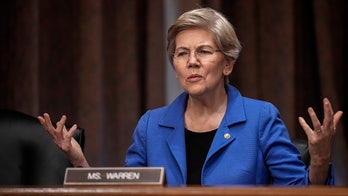Trump unveils strategy to halve legal immigration by 2027
Immigration expert Elvira Salazar and Democratic strategist Jennice Fuentes debate
Congress embarked on one of its most epic struggles in recent memory during the summer of 2011. It was a fight over raising the federal debt ceiling.
The debt limit is the statutory ceiling governing the size of the balance the federal government can carry at any one time. Congress is fast approaching a time where lawmakers will have to either vote on raising the debt ceiling or voting to ignore the benchmark, effectively shutting it off for a fixed period.
The 2011 saga sapped lawmakers. It dragged on from late June, consumed most weekends in July and culminated in a critical August vote. Congress increased the debt ceiling and simultaneously introduced “sequestration,” a set of mandatory federal spending cuts.
The debt ceiling is one of the most vexing roll call votes a lawmaker can cast. No one wants to be on the record voting for more debt. But truth be told, all Congress is doing is permitting the government to spend money the federal government already obligated. Voters excoriate lawmakers of both parties for not slashing spending, but few are willing to accept cuts to Social Security and other entitlements.
It’s a mixed message.
The federal government lived on the cheap since March. That’s when a 2015 agreement brokered between President Obama and former House Speaker John Boehner to suspend the debt ceiling expired. Treasury Secretary Steven Mnuchin has repeatedly told Congress he wants the debt ceiling lifted as soon as possible. Think about this for a moment: Mnuchin is President Trump’s Treasury secretary. The casual observer might ask, didn’t candidate Trump say he’d lower deficits and federal spending?
That could still be in the cards. But no fool he, Mnuchin comes from Wall Street. He knows that a congressional failure to extend the government’s line of credit could jostle world financial markets and force a downgrade of the nation’s credit rating.
Stability is critical in investments. That’s why Mnuchin demands congressional action soon, lest markets go haywire. Mnuchin huddled at the Capitol Tuesday with Senate Majority Leader Mitch McConnell, R-Ky., and Minority Leader Chuck Schumer, D-N.Y. Mnuchin is advocating for a clean debt ceiling hike prior to Sept. 29.
The now oft-criticized Congressional Budget Office (CBO) contends lawmakers have until October to address the debt ceiling. Republicans don’t like the CBO’s math when it comes to its evaluations of GOP health care plans and how many people may will be left without insurance. But you can bet that Republicans will embrace anything the CBO suggests about a longer timeframe in which to tackle the debt limit.
The debt ceiling deadline also presents an opportunity for lawmakers. Congress must reach an agreement to fund the government or face a shutdown Oct. 1. Such a venture will inevitably require a coalition of Democrats and Republicans to come together. Also, Trump may talk tough when it comes to slashing spending. Leaders could Velcro a debt ceiling increase to such a spending bill, thus softening the blow.
House Speaker Paul Ryan, R-Wis., has long argued that deadlines to grapple with the debt limit have historically led to major spending cuts. Again, look to the 2011 package. Also, Ryan and Sen. Patty Murray, D-Wash., authored a 2013 deal that produced some modest savings. Ryan could use possible cuts as an enticement to court the votes of skeptical lawmakers from both sides. Lawmakers are often more willing to up the debt ceiling if budget cuts are involved.
But the question is whether the amount of spending cuts would match – dollar for dollar – the total size of the debt limit increase. It’s doubtful such a plan would require significant entitlement reductions. Granted, Trump and Budget Director Mick Mulvaney proposed a spending blueprint that would alter the government’s spending trajectory and slash some entitlements. But it’s unclear if they’ll ever realize those aspirations.
During the 2011 imbroglio, then-House Majority Whip Eric Cantor, R-Va., led an effort to ensure that Congress offset a debt ceiling increase with a requisite number of cuts. That didn’t happen.
Fierce entitlement cuts would be the recipe for the president and lawmakers to address overall spending and get a claw hold on the nation’s $21 trillion debt. But it’s doubtful anyone has the fortitude for that, despite the tough talk.
Also, what happens when Trump signs a pact that raises the debt ceiling, say, to $24 trillion? Will fiscal conservatives turn on him? How will the president attempt to square that decision with his campaign rhetoric?
It would be foolhardy for the president to veto any legislation to raise the debt ceiling, regardless of the size of potential spending reductions which may accompany the agreement. A failure to do so would put Trump at odds with Ryan, McConnell, and Mnuchin to say nothing of Wall Street investors he professes to know so well. Either Trump and bipartisan lawmakers engineer an historic, breakthrough agreement or there could be market reverberations. There’s no good way for the president to play this hand.
But regardless of the political and economic consequences, Capitol Hill lacks a path to extinguish this possible crisis.
House Democrats often welded debt ceiling hikes to other “must-pass” pieces of legislation. Former House Speaker Denny Hastert, R-Ill., and Majority Leader Tom DeLay, R-Texas, orchestrated a “sneak attack” on the debt ceiling one year. They threw a plan on the floor with about 20 minutes notice.
No one has a plan to address the debt ceiling so far. Congress is still maneuvering around health care, tax reform and reauthorizing the Federal Aviation Administration (FAA). The sides will have to figure out a way to keep the government open in September. And as much as no one wants to deal with the debt ceiling, the issue casts a long shadow in the coming weeks.
Capitol Attitude is a weekly column written by members of the Fox News Capitol Hill team. Their articles take you inside the halls of Congress, and cover the spectrum of policy issues being introduced, debated and voted on there.





